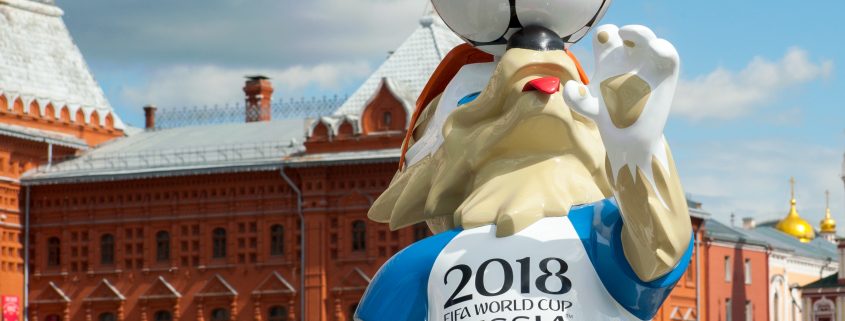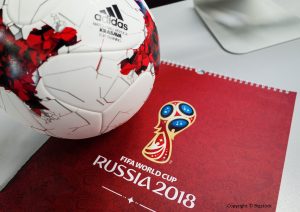This post was first published by Alla Shupineva, 4D Business Communication Agency, Russia
The World Cup will be held on June 14, 2018 in Russia. The events that unite millions of people from all continents have inevitably become not only competitions between the strongest national teams of the world, but also a tournament among advertising and marketing experts. However, before to start the rush for football fans money, it is useful to know some ins and outs and find out “hidden rocks” that may appear in the way of creating the advertising campaign. And that’s what this review is about. Firstly we will talk about FIFA copyrights, associated prohibitions and the ways of bypassing them.
Sponsorship Cooperation with FIFA
Traditionally, companies that have the right to use the world championship symbols are divided into three large groups.
1. FIFA partners – corporations that enjoy full advertising and marketing rights for all competitions held under the auspices of the association.
In 2018, such giants as Adidas, Coca-Cola, Hyundai/Kia, Qatar Airways, VISA, Gazprom and a debutant of the current World Cup – Chinese conglomerate Wanda Group, which signed the contract with FIFA in spring 2016, make the list.
2. Sponsors of FIFA World Cup are companies that reserve the rights for everything that is directly related to a specific World Cup.
Such traditional sponsors as Bud, MacDonald’s, Hisense – a provider of household appliances and electronics, which has already gained experience of sponsoring the 2016 European Football Championship in France, as well as a newcomer, Vivo, Chinese smartphone manufacturer, are responsible for World Cup in Russia.
3. Regional sponsors. A new model of sharing sponsorship positions that replaced national sponsors, involves cooperation with four corporations for each continent. Rumor has it that expecting 2018 World Cup things are not going the way of organizers with the sale of these sponsorship packages. Thus, only Alfa-Bank currently presents Europe, which, within the championship, will be able to offer its services and products to fans.
One may, and another should play it safe
Before and during 2018 World Cup all these corporations will be free to use tournament and FIFA logos, official symbols, make souvenirs, and distribute tickets for matches to promote their products. What should companies that cannot boast of sponsorship packages do? The answer is simple – the same, but without piracy and attempts on marketing rights. In its rules, FIFA notes that it welcomes the use of the World Cup as a newsworthy event for all companies, but clearly points out that they should not produce the illusion of advertisers’ involvement in sponsoring the tournament.
Balls, gates, stadiums, images of fans and countries flags – everything what is associated with football may and should be used. The lack of formal agreements with FIFA does not prevent Nike or Pepsi-Cola from creating bright and eye-catching advertising campaigns time and again, and they are second to none of their competitors.
The list of FIFA requirements that need to be met in order to avoid unnecessary legal red-tape in future is not that big, but there are also hidden pitfalls here. Thus, everything is clear with taboos for the use of official symbols in advertising, as well as FIFA copyright protected photo and video materials. But beyond that point you need to remember, if expecting the World Cup, you hold a lottery or a promotion, you will not be able to raffle tickets for matches. This is only allowed to copyright holders.
Another rule should become golden for owners of bars and cafes, which traditionally expect good revenue during matches. You can attract fans to your bar by all means, but in this case there should not be “copyright” materials both in your advertising products and in the design of a bar counter itself. That is, you will be allowed to put an advertising poster in the window with the announcement of match broadcasting, made in the colors of the Russian flag or in the form of a football. But if it has the World Cup logo or official fonts, also copyright protected, this will be a violation.
FIFA vs Dr. Dre
Failure to comply with the notorious FIFA copyrights strangely enough often becomes one of the main missteps in the World Cup advertising campaigns. However, sometimes advertisers can sail close to the wind using so-called ambush marketing, creating a false impression on the audience about the involvement of their brand in the list of official sponsors of the tournament. Here large dose of humor, pre-planned promotions and even personal arrangements with football players are unleashed.
Thus, during the 2012 UEFA European Championship, Nicklas Bendtner, a forward of the Denmark team, was fined 100 thousand euros for that during the celly he showed the name of the bookmaker’s office on his elastic band. Of course, the company was not included into the list of Euro 2012 official sponsors, and it was unlikely that the Dane could not know this. As a result, bookmakers and the football player himself (who, by the way, is known for a great collection of other tricks) got their dose of fame.
The same occurred during the 2014 World Cup in Brazil. The anger of FIFA was evoked by the producer of headphones Beats by Dr. Dre. Shortly before the World Cup, Beats launched a bright advertising campaign “The Game Before The Game” with such football stars as Neymar, Bastian Schweinsteiger, Luis Suárez and Mario Götze. In fact series of videos did not encroach upon the rights of official sponsors, but after the start of the championship the producer was at the center of a small scandal.
The matter is that the official sponsor of the World Cup was Sony, which typically provided all the participants of the tournament with sets of their devices, which included headphones. However, some players safely ignored the demand to use only sponsors’ products and were regularly caught in focus with Monster Beat headphones. However, the representatives of the corporation said, despite the claims from FIFA, they benefited from that PR.
We can remember another example of how FIFA struggles with ambush marketing from the 2010 World Cup in South Africa. In the second half of Netherlands-Denmark match, 36 young Dutch model-thin women in orange dresses were taken in by stewards. That’d be okay, especially since orange is known to be the national color of the Netherlands, but it was this kind of clothes that the beer company Bavaria Beer sold. Note that, the only brewer who had the right to advertise at the stadium was Budweiser. Despite the fact that there was no company’s logo on the dresses, the fans had to continue at the FIFA office, shrugging off accusation of violating marketing rights.
Tver OFAS vs “Afanasiy”
However, if we keep our mind off large corporations having the opportunity to pay for the mess around such scandals, in reality, the violation of license rights will more likely turn into proceedings with antimonopoly services than into worldwide fame. For example, in St. Petersburg alone several companies were caught in illegal use of FCC symbols in summer 2017. Among others, number of cafes, bars and restaurants got into hot water. Some of them used the Cup’s symbols in indoor decoration, which is forbidden, and a well-known XXXX bars chain got caught using the official logo on their website. Such giants as retailer “Family”, which used the tournament logo to promote beer and chips, and “M-Video” chain, in stores of which were “pirate” posters with Cup symbols, were “interacting” with OFAS (Office of the Federal Antimonopoly Service).
These stories didn’t add karma points to advertisers for sure, although they were disseminated by local media.
Antimonopolists are also vigilant expecting the 2018 World Cup. Thus, in the Tver region, after complaints from FIFA representatives, Afanasiy brewery was held accountable because of the failure to comply with requirements during its promotional activities.
Nevertheless, it is a tribute to PR organisations and people who shortly after the scandal launched a campaign on social networks, created on the confrontation between “Russian manufacturer” and “FIFA mafia”. Both bloggers and thematic publics of vk.com (football, beer and patriotic publics) were involved, there began to appear intriguing posts like: “Football fields are Russian, but beer is foreign”. Russian producers who pay taxes to the Treasury of Russia are not allowed even to mention the forthcoming 2018 World Cup, by likes for our team and a link to the promotion website.
Not only about copyrights
Let’s say you have studied up the rules of using the World Cup official symbols, have understood how to stay out of unnecessary trouble, and are ready to comply with or to bypass the prohibitions. Here are a couple of life hacks that will help you make the advertising campaign attractive and eye-catching.
Catch up in the moment. Watch what happens on football fields; matches with epic scores on boards; who of the “dark horses” suddenly becomes a discovery and a toast; and who of the favorites suffers a sudden collapse. And also follow other scandalous, funny and strange moments, which inevitably grow around any World Cup. Watch and use them, the sooner, the better, because the term of such trends is rather short. Do you remember how quickly and ironically Audi played up the story with the ring that failed to open at the Sochi Olympics, try also to catch up in such a moment. Social networks will help you to speed up the transfer of information to consumers. And it does not matter what exactly you promote: booking tables in your pub to watch cup-final or banking services.
Another life hack is timeliness. Make provision for a rainy day but in good time. Many advertisers are now launching long-running promotional activities, and with each passing month their number will only grow, by the beginning of summer reaching the stage of overall insanity. That is why think of your campaign ahead. And this “ahead” may have different time frames for different goods. Thus, it is better to start advertising gadgets, electronics and a number of other goods long before the start of the World Cup.
For producers of soda, beer and various snacks, as well as for owners of pubs and bars, a week or two counts, when the fans start planning to watch key matches. For food delivery services this is about a day or a couple of hours before the start of the match. At this particular period mass texting and advertising in mobile applications and social networks should be activated.
There are 200 days left until the opening of 2018 World Cup, which means it’s time to start a full-scale preparation of your advertising campaign. Engage your imagination, don’t forget to keep track of football events, observe the rules of fair play. If anything, we will help you ;)
Author: Alla Shupineva, 4D Business Communication Agency, Russia


